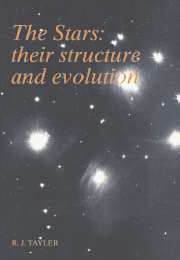Book contents
- Frontmatter
- Contents
- Preface
- Symbols
- Numerical values
- 1 Introduction
- 2 Observational properties of stars
- 3 The equations of stellar structure
- 4 The physics of stellar interiors
- 5 The structure of main sequence stars and pre-main-sequence evolution
- 6 Early post-main-sequence evolution and the ages of star clusters
- 7 Mass loss from stars
- 8 Close binary stars
- 9 Advanced evolutionary phases
- 10 The final stages of stellar evolution: white dwarfs, brown dwarfs, neutron stars and black holes
- 11 Concluding remarks
- Appendix 1 Thermodynamic equilibrium
- Appendix 2 The equation of radiative transfer
- Appendix 3 The pressure of a degenerate gas
- Suggestions for further reading
- Index
4 - The physics of stellar interiors
Published online by Cambridge University Press: 05 June 2012
- Frontmatter
- Contents
- Preface
- Symbols
- Numerical values
- 1 Introduction
- 2 Observational properties of stars
- 3 The equations of stellar structure
- 4 The physics of stellar interiors
- 5 The structure of main sequence stars and pre-main-sequence evolution
- 6 Early post-main-sequence evolution and the ages of star clusters
- 7 Mass loss from stars
- 8 Close binary stars
- 9 Advanced evolutionary phases
- 10 The final stages of stellar evolution: white dwarfs, brown dwarfs, neutron stars and black holes
- 11 Concluding remarks
- Appendix 1 Thermodynamic equilibrium
- Appendix 2 The equation of radiative transfer
- Appendix 3 The pressure of a degenerate gas
- Suggestions for further reading
- Index
Summary
Introduction
In the last chapter I have derived the equations of stellar structure. In these equations there are three quantities, the pressure, P, the energy release per kilogram per second, ε, and the opacity coefficient, K, which depend on the density, temperature and chemical composition of the stellar material. In Chapter 3 I did not discuss how P, ε and K depend on these quantities, and the present chapter is concerned with discussing how P, ε and K are to be calculated if the density, temperature and chemical composition are known. To calculate ε a considerable knowledge of nuclear physics is required and a similar knowledge of atomic physics is required for the determination of K. All three quantities depend on the thermodynamic state of the stellar material. Once ρ, T and the chemical composition are known, the calculation of P, ε and k is pure physics and no further astronomical concepts are required and it is for this reason that this chapter is called The physics of stellar interiors.
Because of the great complexity of the problems involved I am only able to describe the basic processes determining P, ε and k and am not able to give detailed calculations. In the first place, I consider the law of energy release.
Energy release from nuclear reactions
As mentioned in the last chapter, it is now believed that most of the energy radiated by stars has been released by nuclear reactions in the stellar interior.
- Type
- Chapter
- Information
- The StarsTheir Structure and Evolution, pp. 80 - 108Publisher: Cambridge University PressPrint publication year: 1994



